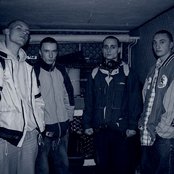While the global impact of hip-hop is undeniable, the focal point of the genre among the Last.fm community may surprise you. The top five cities* for rap music among our users? Łódź, Wrocław, Warsaw, Poznań and Gdańsk. That's right, all cities in Poland.
So how did hip-hop capture the nation of Poland? The rise of hip-hop in the late 1980s can be traced to the country's transition from socialism to democracy and an embrace of the free-market economy. These political upheavals lead to greater stratification among socio-economic lines. The collapse of state-run farms marked the beginning of a drastic degradation in the socioeconomic status of many residents, who essentially formed the new peasant class. Polish hip-hop was a product of this tumultuous context. More specifically, the subculture was born out of the blokowisko. Essentially blocks of apartment buildings found not just in large industrial cities, but rural areas too, these establishments often housed workers of a particular industry, many of whom now found themselves jobless.
Young people in these communities — sometimes referred to as blokersi, a label derived from the settlements in which they lived, or dresiarze, a term which refers to the tracks suits they often wore — were drawn to the genre as they grew politically disenchanted amidst rising unemployment rates. The hip-hop that arose from these conditions is known as cruliczny. Loosely translated as "street hip-hop," the genre took many cues from American Gangster rap; it was confrontational in tone and loaded with references to drugs and crime. An underground scene developed and flourished in cities like Kielce, Katowice, and Warsaw. Musically, it served as a reaction and adversary to the commercially predominant upbeat and optimistic pop of the time, a now highly disparaged genre known as 'disco-polo'.
In the years that followed, a new wave of more Polish-centric hip-hop also emerged. Labeled by journalists as 'inteligentny hip-hop,' this variation was more reliant on local culture and slang than American tropes. Inteligentny hip-hop employed grypsera, a dialect developed by prison inmates in the nineteenth century, which soon evolved into a language used by criminals, as well as old Polish words whose usage had long gone of out vogue. Because of its linguistic creativity, it gained the genre newfound respect among both critics and the public and earned it greater visibility in media. It launched the careers of rappers like Paktofonika (a hip-hop collective from Katowice and Mikołów) , Eldo (who's been heralded for his poetic lyrics, along with his group Grammatik), Fisz and his brother Emade (their music contains elements of avant-garde electronica, funk and jazz) , and O.S.T.R. (more on them later). Since 1998 local rap music has been the nation's dominant form of hip-hop, with fans preferring native Polish artists over international counterparts.
The transition to the mainstream from the underground, like with all genres, entailed greater commercialization. Young teenagers were especially marketed to, being a coveted demographic by not only the music industry but the broader culture as well. As of 2005 there were twenty-seven stores in Warsaw alone that specialized in hip-hop clothing. Of course the commodification of rap culture drew criticism for being less authentic, more derivative and removed from its political aspirations. This corrupted version of the genre earned the dubious nickname 'hip-hopolo'. The suffix 'polo' often connotes bad taste, harkening back to the disco-polo pop that was equally derided. The term has most frequently been applied to artists on Polish record label, UMC Records.
Liroy, one of the pioneers of Polish rap, best embodies, the remarkable trajectory of the country's hip-hop scene. As the best selling rapper in nation and one of the first gangsta rappers in Poland, he achieved great success with his debut album Alboom. He was even hailed by Ice-T as "the real O.G." during the Marlborough Rock Festival in 1995. However despite accolades by his American peers, he experienced a great backlash for financial prosperity, bourgeoisie business ventures, and supposed lack of authenticity. In 2015 he retired from music and pursued a career in politics. He's now a congressman in Poland's lower house of Parliament.
Despite critiques that Poland's rap scene was losing its potency, it remains as popular as ever. There is also a growing desire to reclaim hip-hop from its overly commercialized state. Adam Ostrowski aka O.S.T.R. has become the poster-boy for this movement. His 2004 song 'Odzyskamy Hip-Hop' loosely translates to "We'll get hip-hop back" and decries the "business whores who stole hip hop". The Łódź native is exceedingly popular. With 193 listens per user, he transcends genre and geography to has the most passionate following among all Last.fm listeners.
Other data corroborates our findings as well. In 2011, five of the top ten
YouTube clips shared in Poland were of rap videos. As of that year, they were viewed over a combined total of half a million times. More notably all of the rappers were natives of Poland, and of the country's current
Key Tracks
Paktofonika - Jestem Bogiem (837,000 Scrobbles, 54,600 Listeners)
O.S.T.R. - Dla Tych Kilku Rzeczy (314,800 Scrobbles, 47,700 Listeners)
Grammatik- Friko (161,000 Scrobbles, 15,300 Listeners)
Donatan - Z Samym Sobą (feat. Sokół) (63,900 Scrobbles, 6,332 Listeners)
Liroy - Impreza (27,000 Scrobbles, 4,904 Listeners)
Follow Last.fm elsewhere:
Facebook | Twitter | YouTube | Instagram









